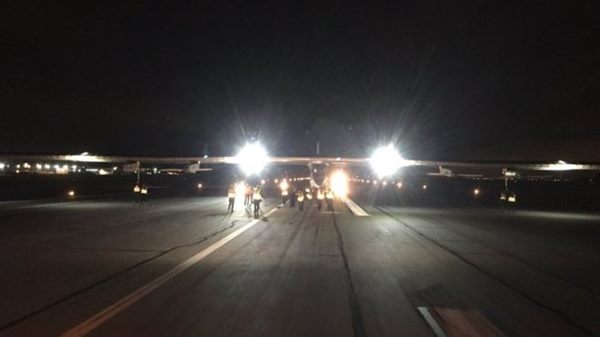
London, UK (BBN)-The solar-powered aeroplane Solar Impulse has landed in Silicon Valley, California, after a three-day flight over the Pacific Ocean.
High winds delayed the landing at Moffett Airfield, Mountain View, as pilot Bertrand Piccard flew in a holding pattern off the coast, reports BBC.
The plane left Hawaii on Thursday, after eight months of repairs following battery damage on a flight from Japan.
This is the ninth leg of its attempt to fly round the world.
Solar Impulse started its journey last March in Abu Dhabi. The trip has involved two different pilots flying separate legs.
Solar Impulse gets all its energy from the sun, and has 17,000 photovoltaic cells on its top surfaces.
These power the craft's propellers during the day but also charge batteries that the vehicle's motors can then call on during the night.
The distance on this leg was 4,000km or 2,200 nautical miles.
Starting in Abu Dhabi, UAE, in March, Solar Impulse crossed Oman, India, Myanmar, and China.
It then flew to Japan, before undertaking a 8,924km passage to Hawaii. That five-day, five-night crossing set a record for the longest ever non-stop solo aeroplane journey.
However, the vehicle's batteries overheated during the trip, forcing the project to stop on the Pacific archipelago while repairs were conducted.
A further 20m euros (£16m; $23m) had to be raised from supporters during the winter to keep the project going for another year.
Mr Piccard shares flying duties with his business partner, Andre Borschberg.
It was Mr Borschberg who flew into Kalaeloa last July, and he will take the controls on the next leg across the US mainland.
The pair's intention is to reach New York by the start of June, to begin preparations for an Atlantic crossing.
Assuming this is completed successfully, it should then be a relatively straightforward run back to the "finish line" in Abu Dhabi.
Mr Piccard and Mr Borschberg have been working on the Solar Impulse project for more than a decade.
The plane's wingspan is wider than a 747 jumbo jet, and yet it weighs only 2.3 tonnes.
Because the prop-driven craft moves so slowly, mission legs can take several days and nights of continuous flight.
This means the pilot has to stay alert for nearly all of the time the plane is airborne - they are permitted only catnaps of up to 20 minutes, in the same way a single-handed, round-the-world yachtsman would catch small periods of sleep.
They also have to endure the physical discomfort of being confined in a cockpit that measures just 3.8 cubic metres in volume - not a lot bigger than a public telephone box.
But Mr Borschberg says the experience so far has been exhilarating.
"An experimental plane is a living creation," he told BBC News. "Each flight you do brings new learning that you can use to improve the quality, reliability and performance of the aeroplane."
LEG 1: 9 March. Abu Dhabi (UAE) to Muscat (Oman) - 772km; 13 Hours 1 Minute
LEG 2: 10 March. Muscat (Oman) to Ahmedabad (India) - 1,593km; 15 Hours 20 Minutes
LEG 3: 18 March. Ahmedabad (India) to Varanasi (India) - 1,170km; 13 Hours 15 Minutes
LEG 4: 18 March. Varanasi (India) to Mandalay (Myanmar) - 1,536km; 13 Hours 29 Minutes
LEG 5: 29 March. Mandalay (Myanmar) to Chongqing (China) - 1,636km; 20 Hours 29 Minutes
LEG 6: 21 April. Chongqing (China) to Nanjing (China) - 1,384km; 17 Hours 22 Minutes
LEG 7: 30 May. Nanjing (China) to Nagoya (Japan) - 2,942km; 1 Day 20 Hours 9 Minutes
LEG 8: 28 June. Nagoya (Japan) to Kalaeloa, Hawaii (USA) - 8,924km; 4 Days 21 Hours 52 Minutes
LEG 9: 21 April. Kalaeloa, Hawaii (USA) to Mountain View, California (USA) - 4,200km
BBN/SK/AD